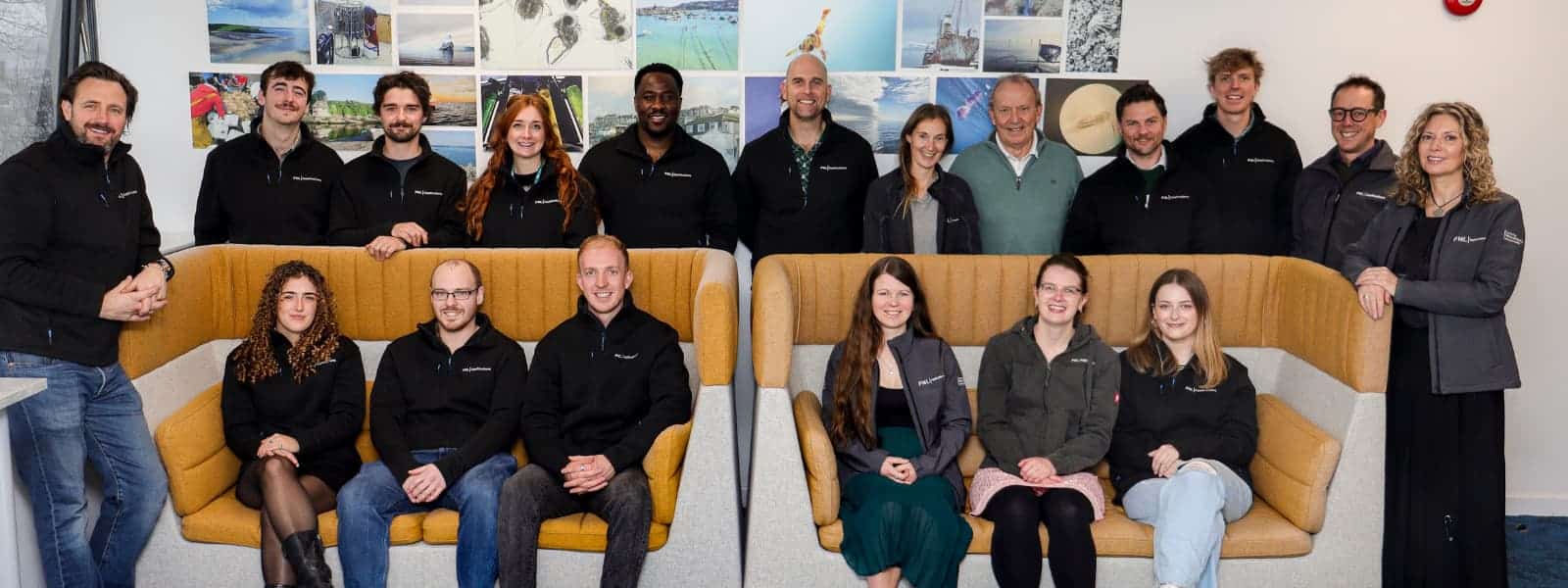As a marine environmental consultancy, PML Applications is uniquely positioned due to our close work with Plymouth Marine Laboratory (PML) scientists. We have a demonstrable track record as industry-leaders in applied marine science that supports improved decision-making and creates frameworks to help us, our clients, and wider society understand, protect and harness the power of our oceans.
In this article, we are shining a spotlight on the incredible work that PML Applications and PML carry out in their service provisions and impactful research.
1. Detection of Oil Slicks and Shipping Emissions
With much of the world’s international trade carried out via shipping, it is important to understand the significance of its environmental impact and influence policies and regulations with the best scientific evidence, such as the research carried out at PML Applications and PML.
While there are many potential pollutants from the shipping industry, a key discussion for climate change surrounds shipping emissions and measuring their impact. There are many factors to consider during manufacture, operation and maintenance that can help reduce carbon emissions; PML Applications works to test and advise on this.
As Earth Observation (EO) research techniques and technologies have advanced rapidly in recent years, we have seamlessly incorporated EO expertise and data, collected from satellites, drones and other remotely operated sensors, into our projects. With a world-leading team of EO specialists working at PML Applications and PML, there are many areas where they assist our projects, including remote oil slick detection. EO data can help us detect changes in the marine environment that could indicate an oil spill and also provide insight into how widespread an incident has become.
2. Effects of Marine Biofouling
Shipping, aquaculture and offshore renewable energy industries, as well as navy defence, are key sectors for PML Applications and PML, with a particular focus on biofouling management. By managing biofouling and testing antifouling coatings and in-water cleaning technologies to use the most effective combinations possible, we reduce hull skin friction caused by biofouling to reduce fuel consumption, therefore reducing greenhouse gas emissions, biosecurity concerns and operational costs.
PML Applications has established itself as a leading test facility for evaluating different types of anti-fouling and cleaning technologies for a wide range of user cases. Coatings and cleaning systems both need to be optimal for each user case to establish the least environmentally harmful but most effective methods.
Alongside these studies are projects that investigate the biosecurity implications associated with marine biofouling including prevention strategies as well as surveys and monitoring for all marine sectors. Non-native species are considered the third greatest threat to the loss of biodiversity, and so prevention strategies as well as surveys and monitoring are a key priority for all maritime industries.
- PML Applications Scientist Contributes to Groundbreaking Marine Metal Lifespan Model
- PML Applications Contributes to Major UN Report on Marine Biofouling
3. Riverine, Estuarine and Marine Water Quality Monitoring
Our research and studies expand beyond the marine environment and into associated areas, such as rivers and estuaries. By monitoring water quality at different stages, we can build an accurate picture of the impact of water pollution, and whether the impact stems from human, industrial or agricultural waste. The AgZero+ project, in particular, is a long-term study monitoring nutrient and carbon transport in estuaries and assessing potential solutions to these problems such as introducing beavers, artificial water flow modifications and saltmarsh restoration.
- Experts and Leaders Unite to Tackle Water Pollution in Devon
- Protecting valuable aquatic ecosystems through improved satellite monitoring of water quality
- The AgZero+ project: our work to protect rivers… and the ocean.
4. Impacts of Offshore Renewable Energy
Offshore renewable energy invokes plenty of questions around the impact of sound pollution and corrosion, impacts on nearby wildlife and other potential changes to the ecosystem and the industries that rely on the spaces near installations. When it comes to other types of offshore renewable energy, such as tidal turbines, PML Applications’ biofouling projects focus on research about the impacts of human-made underwater structures at sea and how they impact the health of our oceans. The work at PML Applications and PML offers evidence-based solutions to these types of questions through research studies and the development of best practices. We take it a step further by directly influencing policy and creating industry frameworks.
- Safeguarding marine animals amid the UK’s offshore wind energy expansion
- “Strategically placed” offshore structures could enhance ecosystem resilience
5. Frameworks and Best Practices
Our aim is to ensure that our internationally-recognised research and considerable expertise are of benefit to other stakeholders, such as policy makers, industry and environmental regulators. We achieve this by creating well-researched and realistic frameworks and best practices to reduce the environmental impact of various marine-related activities or by contributing to policy development.
Examples of the areas where we are leading research and development include Marine Carbon Dioxide Removal (mCDR) and Ocean Alkalinity Enhancement (OAE). These innovative initiatives could pave the way for society to use the ocean as a resource for carbon dioxide removal and storage. However, PML Applications and PML take the approach of not creating a new environmental problem by solving another. To this end, we develop frameworks to support the monitoring and testing of environmental impacts in order to help these types of novel projects proceed mindfully and sustainably.
- Sam Fawcett To Present At Carbon to Sea Annual Convening in Washington, D.C.
- MEDIA: project to suck carbon out of sea begins in UK
6. Harmful Algal Bloom Detection and Analysis
Algal blooms can tell us about the health of our oceans and highlight the wider climate change impact. PML scientists study algal blooms in great detail and are also working on ways to detect harmful algal blooms earlier. By detecting them earlier, we can minimise their impact on marine life, human health and industry by taking action before they can have a negative impact. Research also suggests that algal blooms could be contributing to ‘ocean darkening’ by reducing light penetration.
- New project funded to boost early detection of algal blooms for cleaner, safer drinking water
- New study reveals global ‘Ocean Darkening’ threatens marine life
7. Research and Impact of Nutrients/Eutrophication
While at first thought it may appear to be positive that our waters are nutrient-rich, having too much of certain nutrients, such as nitrogen, can have major implications for our ecosystems. Research carried out by PML explores the urgent need to look at the real environmental impact of excess nutrients and has already identified a link between nutrients and events, such as algal blooms, and extreme growth of marine life and plants, such as sargassum.
- Project to tackle nitrogen pollution in the Maldives launched
- Sargassum, the free-floating seaweed proliferating with climate change
8. Impact of Chemical and Heavy Metals Pollution
Adding human-made materials and chemicals into our ocean is not a new subject of study but what we aim to understand is the longer-term implications of these substances. For example, the discussion often revolves around ‘forever chemicals’ and the impact they have on our ocean from everyday products, such as sunscreen. Our scientists work to understand and provide evidence of this impact in order to influence policy change.
- View from above: monitoring the impacts of flooding on river water quality using optical sensors
- Monitoring water quality in Plymouth Sound and beyond
- Sunscreen’s potential impact on marine life needs urgent investigation, new study reveals
9. Detection and Impact of Microplastics
PML is a leader in the study of microplastics and has become a valued and recognised centre of microplastic research. Not only are the award-winning team experts in detecting the presence and composition of microplastics but also in determining their impact and working on solutions to clean up our oceans and other waterways.
- Impacts of mixed microplastics on marine life
- Marine Plastic Pollution: A breeding ground for disease-causing bacteria
- Widespread microplastic pollution in Peruvian mangrove sediments and edible mangrove species
10. ALAN and Anthropogenic Noise Pollution Impact
Artificial Light at Night (ALAN) is not just a problem on land but also at sea. The work carried out by PML scientists will help to start bridging knowledge and research gaps and bring attention to the impact of ALAN in our rivers, estuaries, coast and further out to sea. To keep our oceans undisturbed, it is important to consider a range of pollution types, including light, to get a better picture of the environmental impact humans have on our seas.
- Illuminating Ocean Threats on Day Two of the World Ocean Summit
- PML and the University of Plymouth bring the issue of artificial light pollution to Parliament
- First map of European aquatic habitats with both light and noise pollution revealed
If you would like to discuss any of the topics in this article and the services we provide, contact the team here or email forinfo@pml-applications.co.uk



